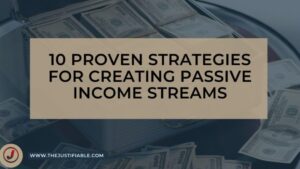Table of Contents
The best way to save money isn’t always obvious, especially when every paycheck already feels stretched thin. What if you could find hidden savings without completely cutting out the things you enjoy?
Is it possible to save quickly without needing a second job or a drastic lifestyle change? In this guide, we’ll break down practical strategies that work on any budget and show you step-by-step how to reach your savings goals faster.
Track Every Expense To Spot Hidden Savings
If you don’t know where your money is going, you can’t take control of it. Tracking expenses sounds boring, but it’s one of the best ways to save money fast.
The moment you see your spending patterns laid out clearly, the leaks in your budget become obvious—and fixing them feels like free money.
Use Simple Budgeting Apps To Stay Organized
I recommend starting with apps like Mint, YNAB (You Need a Budget), or even something as simple as Google Sheets.
Mint connects directly to your bank and credit cards, automatically categorizing spending into groceries, dining, gas, and so on.
YNAB takes it a step further by forcing you to “give every dollar a job,” so you don’t have stray money floating around.
Here’s a quick tip: Set up spending alerts in the app dashboard. For example, in Mint, you can go to Settings > Budgets and set a limit for dining out. If you exceed that limit, you’ll get a push notification. That single nudge can stop a random $25 lunch from derailing your week.
Identify Small Daily Purchases That Add Up Fast
It’s rarely the one-off $200 purchase that sinks you—it’s the $7 coffee, $15 lunch, or $12 streaming service you forgot about. One latte a day is about $150 a month.
That’s $1,800 a year. Once you see these micro-spends stacked together, you realize cutting just two or three of them could fund a vacation, pay down debt, or build your savings cushion.
I suggest making a 7-day challenge: write down every single dollar you spend. By the end of the week, circle the purchases that didn’t actually make your life better. You’ll know immediately which ones are worth cutting.
Separate Needs From Wants Without Feeling Deprived
The danger with saving is going too extreme and burning out. You don’t need to give up every little joy. Instead, create rules that work for you.
For example, you might allow yourself two fancy coffees a week instead of seven, or one night out instead of three.
What helps is creating a “fun money” category in your budget. Allocate a set amount—say $50 a week—for guilt-free spending. That way you get the psychological relief of treating yourself without breaking your savings momentum.
Cut Recurring Bills Without Sacrificing Quality
Recurring bills are sneaky. They quietly drain your money month after month, and because they’re automatic, you barely notice them.
Cutting even two or three recurring expenses can save you hundreds of dollars every year without feeling like you’re missing out.
Negotiate Lower Rates On Internet, Cable, Or Phone Plans
Here’s something I’ve personally tested: call your internet provider once a year. Just say, “I’m considering switching to a competitor unless you can offer me a better rate.” I’ve had my internet bill drop $20 a month with one phone call. That’s $240 saved a year for 15 minutes of effort.
Many providers also have “loyalty discounts” they won’t tell you about unless you ask. Check the provider’s website for promotions aimed at new customers, then ask to match that rate.
Cancel Subscriptions You Rarely Use
Take a look at your app store subscriptions or your credit card statement. You might find you’re paying for multiple streaming services, gym memberships you never use, or apps you forgot to cancel after the free trial.
I recommend using a tool like Rocket Money. These apps scan your transactions, highlight all subscriptions, and let you cancel them with one click. A friend of mine realized she was paying for three different music streaming platforms. Cutting down to one saved her almost $40 a month.
Switch To Energy-Efficient Habits That Lower Utilities
Utilities are another area where small changes stack up. Here are some quick wins:
- Swap out incandescent bulbs for LED bulbs—they use about 75% less energy.
- Lower your thermostat by 2–3 degrees in winter, and raise it slightly in summer.
- Unplug chargers and electronics when not in use, since “phantom power” still costs money.
In practice, these changes can shave $20–$40 a month off your electricity bill. Over a year, that’s enough to cover a decent emergency fund contribution.
Meal Planning As A Proven Money-Saving Strategy
Food is one of the biggest budget busters. Eating out feels convenient, but it drains cash fast.
Meal planning is hands-down one of the best ways to save money, because it removes the last-minute “what should I eat?” problem that usually ends in takeout.
Create Weekly Menus To Avoid Last-Minute Takeout
Here’s how I do it: every Sunday, I sit down and plan 4–5 dinners for the week. I keep it simple—two easy pasta dishes, a sheet-pan meal, maybe one slow-cooker recipe. I write the plan on a sticky note and put it on the fridge.
The beauty of this is you don’t have to decide “what’s for dinner?” every night. You already solved that problem once, and the ingredients are waiting for you. By just replacing two takeout nights with planned meals, you could save $80–$100 a week.
Buy Groceries In Bulk And Freeze For Later
Bulk shopping doesn’t mean filling a cart with random deals. Focus on staples you know you’ll use: rice, pasta, chicken, frozen vegetables. Buying a 10-lb bag of rice costs less per serving than buying smaller packs repeatedly.
When you buy meat in bulk, portion it into freezer bags. I label each bag with the date and type of meat. Having pre-portioned protein ready to thaw makes it much easier to cook instead of ordering Uber Eats.
Use Discount Apps And Coupons Strategically
I’m not talking about extreme couponing with binders full of clippings. Apps like Ibotta, Fetch Rewards, and Flipp make it ridiculously easy.
With Ibotta, you just scan your receipt, and the app sends you cashback for eligible items. Fetch Rewards works similarly but gives you gift cards instead.
Even stacking a $5 rebate here and a $10 reward there adds up. If you’re already grocery shopping, why not let the apps chip in on your savings?
Automate Savings Before You Can Spend It
One of the best ways to save money is to take the decision-making out of your own hands. If the money moves to savings before you even see it in your checking account, you won’t feel tempted to spend it.
This is where automation becomes your best friend.
Set Up Automatic Transfers On Payday
Here’s how I suggest you do it: log into your bank’s app, go to Transfers > Recurring Transfer, and schedule a fixed amount to move into your savings account the same day your paycheck hits. Even if it’s just $25, the consistency matters more than the amount.
Think of it as “paying yourself first.” You wouldn’t skip rent or your phone bill, so don’t skip savings either. The trick is to treat it as non-negotiable.
Over a year, even a modest $50 transfer per paycheck adds up to $1,300 without you lifting a finger.
Use Round-Up Apps To Save Spare Change Effortlessly
If the idea of a big transfer feels too aggressive, start with something painless. Round-up apps like Acorns automatically round up each purchase to the nearest dollar and stash the difference. Buy a coffee for $3.60, and 40 cents goes to savings.
The beauty here is you won’t miss it. I’ve seen people build $300–$500 a year just by letting these micro-transactions quietly work in the background.
Some apps even let you invest those round-ups, which makes the growth even stronger over time.
Open A Separate Savings Account To Avoid Temptation
I believe this step is essential: open a savings account at a bank different from your primary checking. The harder it is to instantly transfer money back, the more likely you’ll let it grow.
Some people use high-yield savings accounts from online banks like Ally or Discover, which often pay interest rates 10–12x higher than traditional banks. That way, your money isn’t just sitting—it’s working for you.
Reduce Transportation Costs Quickly
Transportation is usually the second-biggest expense after housing. Gas, car maintenance, and commuting all eat into your budget.
Cutting these costs is one of the most effective ways to save money fast without sacrificing much in daily life.
Carpool Or Use Public Transportation To Save Gas
Gas prices fluctuate, but one thing never changes: driving solo is expensive. If you live near coworkers or neighbors heading the same direction, set up a carpool schedule. Splitting gas even two or three times a week can save you $50–$100 a month.
Public transportation can also be a game changer. Monthly passes are often cheaper than what you’d spend on gas plus parking.
Even swapping one or two driving days for public transit can make a noticeable difference in your budget.
Maintain Your Car To Prevent Costly Repairs
Here’s a truth I learned the hard way: skipping oil changes or tire rotations doesn’t save you money—it costs more in the long run. A neglected $40 oil change can turn into a $1,500 engine repair.
Keep a simple checklist:
- Oil change every 3,000–5,000 miles
- Tire rotation every 6,000–8,000 miles
- Air filter replacement once a year
Most modern cars even track this for you in the dashboard. Staying on top of maintenance not only saves money, but it also keeps your car’s fuel efficiency higher, which lowers your gas bill too.
Consider Biking Or Walking Short Distances
If your errands are within a mile or two, ditching the car is a double win. You save money and get exercise at the same time.
For example, biking to work just twice a week instead of driving could save hundreds in gas and parking over a year. And if you’re lucky enough to live in a walkable area, turning that quick trip to the corner store into a 10-minute walk is basically free savings.
Sell Items You Don’t Use To Generate Extra Cash
Saving money doesn’t just mean cutting expenses—it can also mean bringing in extra income. One of the easiest ways to do this is by decluttering and selling things you no longer use.
List Clothes, Electronics, And Furniture Online
Start with clothes that don’t fit, old electronics collecting dust, or furniture taking up space. Platforms like Poshmark, eBay, and Facebook Marketplace make listing simple.
For example, on Poshmark, you just snap a few photos of clothing, upload them in the app, and set a price. They even send you prepaid shipping labels once the item sells. It’s one of the quickest ways to turn a closet clean-out into cash.
Use Local Marketplaces For Faster Sales
If you want speed, I recommend local platforms like Craigslist, OfferUp, or Facebook Marketplace. Larger items like couches, bikes, or kitchen appliances tend to sell faster locally since people prefer not to ship.
When I sold an old dining table, I listed it on Facebook Marketplace and had three offers within 24 hours. Local selling is not only quick but avoids shipping fees entirely.
Reinvest Earnings Directly Into Savings
Here’s where most people go wrong: they earn a few hundred from selling stuff and immediately spend it on something new. Instead, I advise moving those earnings directly into your savings account.
Think of it as converting clutter into financial progress. If you sell just $300 worth of unused items and deposit it right away, that’s an instant savings boost without touching your paycheck.
Adopt The 24-Hour Rule Before Spending
Impulse spending is one of the biggest enemies of saving. You see something you “have to have,” swipe your card, and regret it later.
The 24-hour rule is a simple habit that gives your brain time to catch up with your emotions before you spend.
Pause Before Making Impulse Purchases
Here’s how it works: if you want to buy something that’s not essential, wait 24 hours before pulling the trigger. Put it in your online cart, bookmark the page, or write it on a sticky note. Most of the time, the urge fades, and you realize you didn’t really need it.
I’ve personally done this with everything from tech gadgets to kitchen tools. More than half the time, after sleeping on it, I don’t want the item anymore. That’s money staying in savings instead of being wasted.
Compare Prices Across Stores And Online Shops
If you do decide you still want it after 24 hours, take the time to compare. Retailers love to play pricing games. The same pair of headphones might be $89 at one site and $65 at another.
I recommend using tools like Capital One Shopping. They run in your browser and automatically check for better prices and coupons. This way, you’re not only avoiding impulse buys, but also ensuring you pay the lowest price if you go through with it.
Focus On Value Instead Of Just Discounts
A mistake people make is buying something just because it’s on sale. A $200 jacket marked down to $120 isn’t a savings if you didn’t need it in the first place. Instead, focus on the value it will bring you.
Ask yourself: will I use this item often? Does it replace something I already own? Does it improve my daily life? This shift in thinking saves more money than any coupon ever could.
Take Advantage Of Cash-Back And Reward Programs
Earning rewards on purchases you’d make anyway is one of the best ways to save money faster. The trick is to be intentional, not reckless, with these programs.
Use Credit Cards With High Cash-Back Categories Responsibly
If you pay your credit card bill in full each month, a cash-back card is essentially free money. Many cards offer 2–5% back on categories like groceries, dining, or gas.
Here’s an example: if you spend $400 a month on groceries and your card offers 3% cash-back, that’s $12 a month or $144 a year going back into your pocket. Just remember, if you’re carrying a balance, the interest wipes out the benefit.
Join Store Loyalty Programs For Extra Discounts
Almost every grocery store, pharmacy, or coffee chain has a free loyalty program. Signing up takes less than five minutes, and the savings are immediate. For example, many supermarkets mark certain items “member price only.”
I suggest creating a separate email just for loyalty accounts. That way, you get the discounts without drowning in promotional emails.
Track Reward Points To Maximize Redemptions
The biggest waste is letting points expire unused. Keep track of your rewards in your banking app or with a tool like AwardWallet, which automatically updates balances across programs.
I’ve redeemed points for gift cards that covered holiday shopping, or airline miles that shaved $300 off a flight. Treat points like currency—they’re part of your savings strategy, not just a perk.
Limit Entertainment Spending Without Missing Out
Entertainment is important—you don’t want to live a life that feels deprived. The goal is to spend less without sacrificing joy. With a few swaps, you can enjoy yourself and still save money.
Replace Expensive Nights Out With Free Local Activities
Check community boards or city websites for free events: outdoor concerts, art walks, or open-air movie nights. In many cities, libraries even lend out free passes to museums or local attractions.
One summer, I replaced three $60 nights out with weekly outdoor movie screenings in the park. Same fun, way less cost.
Use Streaming Services Strategically Instead Of Multiple Subscriptions
It’s easy to sign up for Netflix, Hulu, Disney+, and Prime Video—suddenly you’re paying $60+ a month just on streaming. Instead, rotate services. Keep one at a time and switch every couple of months.
Most platforms save your watchlist, so you won’t lose progress. This approach lets you enjoy all the shows you want without paying for everything all at once.
Host Game Nights Or Potlucks With Friends
Instead of hitting restaurants or bars, invite friends over. A potluck dinner where everyone brings one dish is cheaper and often more fun than dining out.
Board games, trivia apps, or even a DIY karaoke night turn into memorable evenings without the hefty bill. I’ve hosted potlucks where the entire night cost me under $20, compared to $80 at a restaurant.
Set Clear Short-Term Savings Goals
Without clear goals, saving feels abstract and easy to quit. Setting specific, short-term targets gives your savings a purpose—and purpose fuels motivation.
Write Down Specific Targets Like Emergency Funds Or Trips
Don’t just say, “I want to save more.” Write down: “I want $1,000 in my emergency fund by June” or “I want $500 for a weekend trip by October.” Goals should be concrete and time-bound.
I advise keeping these written somewhere visible—on a fridge sticky note, in your budget app, or even as your phone lock screen. Seeing the goal daily keeps you focused.
Break Large Goals Into Smaller, Achievable Steps
A $1,000 savings target can feel overwhelming. Break it into smaller pieces: $20 a week or $80 a month. Each time you hit one of those smaller milestones, you’ll feel progress instead of frustration.
Apps like YNAB or Qapital let you create goal trackers that show how close you are in real time. Watching that progress bar move is a powerful motivator.
Celebrate Milestones To Stay Motivated
When you reach a milestone—say $500 saved—celebrate it. That doesn’t mean spending $200, but give yourself a small reward: a special coffee, a movie night, or something meaningful within your budget.
Celebrating progress turns saving from a chore into a rewarding habit, making it more likely you’ll stick with it long-term.
Expert Tip To Save Money Faster
The single biggest accelerator is removing friction. Automate transfers, cut decisions with meal planning, and use default settings that push you toward saving. When saving money doesn’t rely on willpower, it becomes consistent.
I suggest this one-two punch:
- Automate a set transfer each payday.
- Funnel all “extra” money (cash-back rewards, side hustle income, or sales from decluttering) directly into savings.
That combination gives you steady progress plus momentum boosts. Over time, these small systems create surprising results—like watching a jar fill slowly with coins until one day it’s overflowing.






